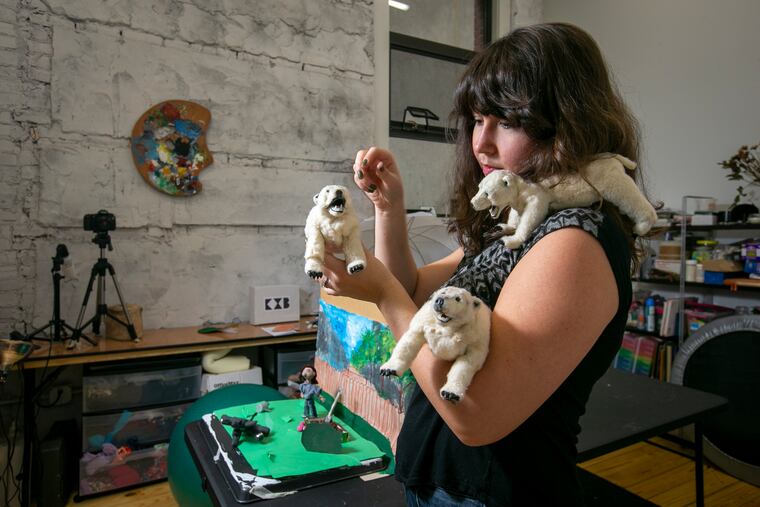Animation art program for refugee and immigrant children is on pause until a new sponsor steps up
The children found a respite from the challenges of life in an unfamiliar land, gaining self-confidence and creativity.

Klementina Budnik wants to animate the lives of immigrant and refugee children.
But she can’t do it alone.
For three years, Budnik, the founder of a small Germantown production company called KXB Studio, offered free classes in film animation to elementary and middle school students in Northeast Philadelphia who had come here from around the world, from places like Iraq, Syria, Somalia, and Afghanistan.
Together the kids learned the intricacies of such techniques as stop-motion animation, a painstaking process in which clay or plasticine figures are moved ever so slightly, filmed, and then moved again. They also made paper superhero versions of themselves, and added drawings and music to the productions, which were shown to family members and friends at special screenings. Some of their films found an afterlife on the internet.
Budnik, 28, said the children enjoyed a respite from the challenges of life in an unfamiliar land, gaining self-confidence and creativity. But the program, held each Tuesday at the Gilbert Spruance Elementary School, ended last December when its sponsor, HIAS Pennsylvania, restructured its after-school programming to focus on individual instruction at other sites.
“Klementina used her artistic skills to inspire our kids to express themselves in ways they had never done before,” said Daniella Nahmias Scruggs, a spokesperson for nonprofit HIAS Pennsylvania, which provides support services to immigrants, refugees, and asylum-seekers. “Using animation was a great way for kids who felt uncomfortable speaking English to share their stories.”
Now Budnik is searching for ways to get the classes restarted, and hoping a new sponsor or agency might step forward.
Among the 50-some children who have taken part in the program are the two daughters of Ali Arif, originally of Baghdad. “They learned a lot,” he said. “It’s not only about learning the specific activity, it’s about bonding with the other kids.”
He, his wife, and daughters came to the United States in 2017, granted entry because of his work assisting American military forces in translation and cultural understanding following the 2003 invasion of Iraq.
His first job here was as a tour guide in the Middle East galleries at the Penn Museum. Today he and his wife, Lara, work for the Philadelphia School District — he’s a bilingual counseling assistant, she’s in administration — and seek out opportunities like the animation class for the girls.
“The program was amazing,” said Yara Abdalstar, 9. “We take clay and make our own character, then our art teacher will take pictures of it moving.”
Her sister, Roz Abdalstar, 11, added, “I loved how we can use clay.”
Home to nearly 45 million people who were born in another land, the U.S. has more immigrants than any country. At the same time, the world is facing its worst refugee crisis since World War II, with an estimated 26 million people forced from their homelands, according to the United Nations.
That occurs as the doors to the U.S. have been narrowed by a Trump administration that has worked to reduce virtually every form of immigration. The annual cap on admissions of refugees has been repeatedly lowered, with the administration seeking a ceiling of 15,000 in 2021. That’s down from 80,000 in 2010.
Budnik knows what it’s like to come to a new country.
She was born in Kiev, in Ukraine, and her family immigrated to South Jersey when she was 18 months old. In Cherry Hill, a preschool teacher noticed her ability to draw, prompting Budnik’s mother to enroll her in art classes.
She graduated from Cherokee High School in Marlton, and then from a dual program at Tufts University and the Museum of Fine Arts in Boston.
“The classic tale of immigrant parents is they want you to become a doctor or a lawyer, but they were always incredibly supportive of my art,” Budnik said.
She worked as a freelance artist and taught animation at after-school programs and summer camps. In 2015, she started her own animation studio in Boston, then moved a year later to Philadelphia, where she grew the firm to include videos and commercials for musicians and businesses.
“At the time, there was a lot of stuff in the news about migrant children and them being put in detention camps. And not having a childhood,” she said. “That hit really close to home for me. I wanted to do something about it.”
For Budnik, street protests didn’t feel like a fit. She wanted to volunteer, and she contacted HIAS Pennsylvania to offer the animation class, where the children’s ages ranged up to 13.
“They were so drawn to the creative stuff,” she said. “Some of the kids were using the art to process their feelings. They’ve been through a lot.”
Now the pandemic has limited social contacts and stretched the resources of nonprofit groups that could offer support. Programming has moved online even for children. She’s certain, though, that there’s a way to get her program reanimated and helping children.
“Whether they got something artistic out of it or not, they had a rest from being immigrants and refugees in a new country,” she said. “They could just let loose and see what happened.”